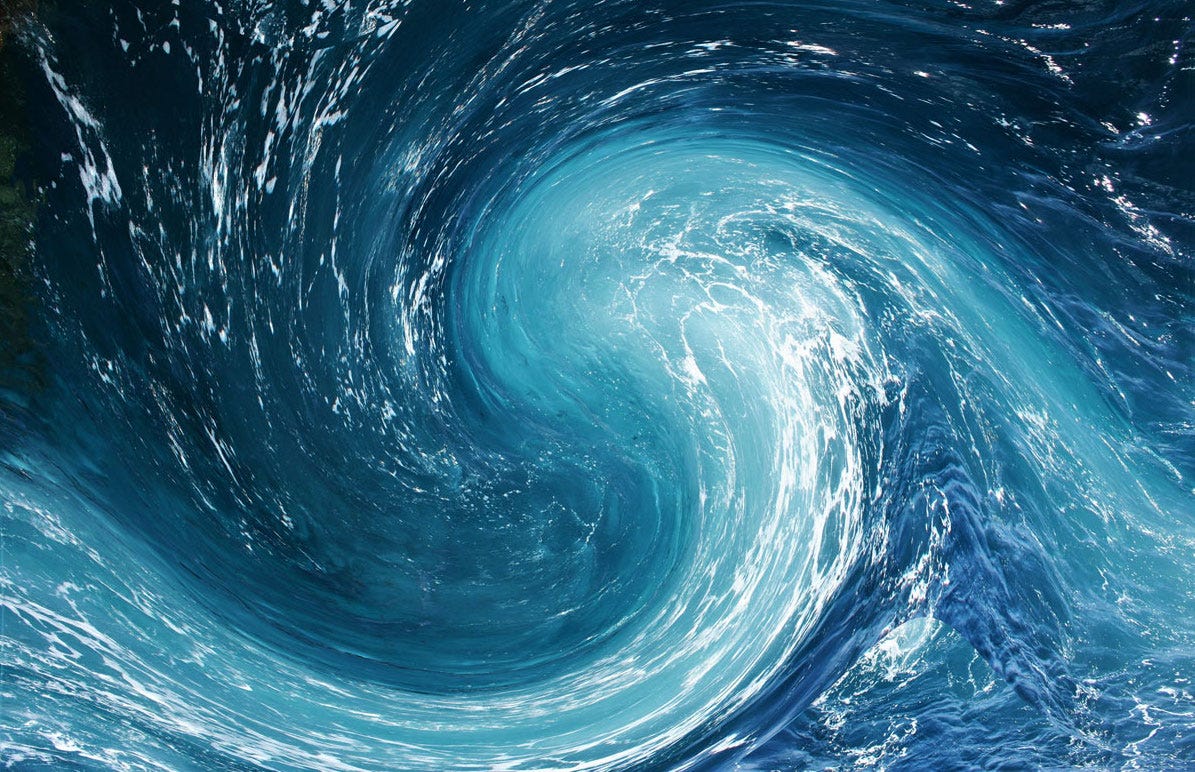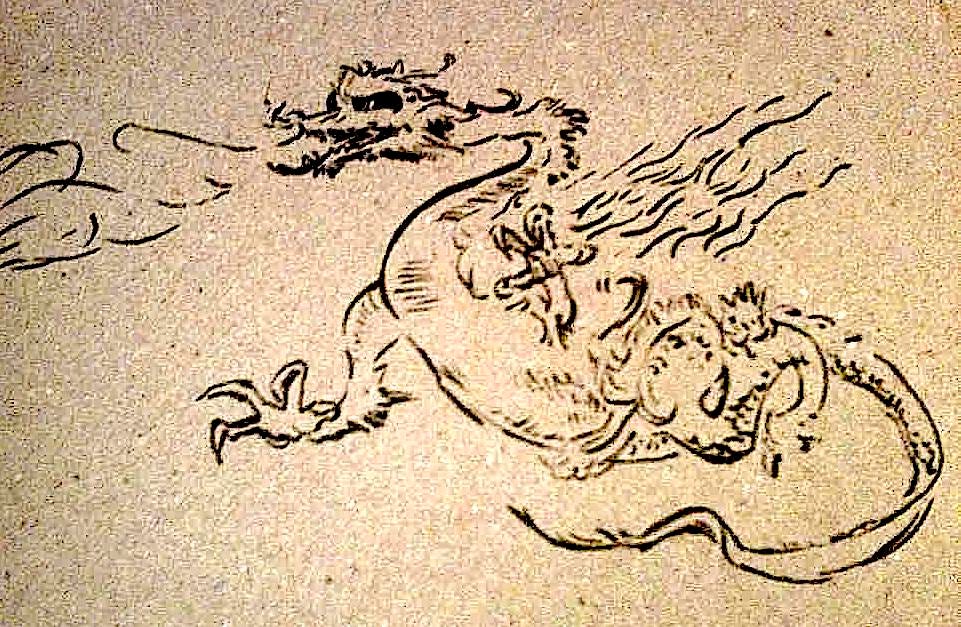Year of the Dragon!
Feilong, the flying dragon (飛龍), soars above the world and surveys all below. One can cower in fear at the sight of this imposing creature or one can try to see and understand the terrain from a higher perspective. Having an overview perspective can make clearer what one needs to do to avoid pitfalls that cannot be seen at eye level.
Similarly, if one can observe the flow of one’s life, changing world events, one’s place in the cosmos, and the significance of one’s practice from such a dragon’s-eye perspective all can be understood and undertaken more profoundly.
But how does one cultivate overview-thinking habits?
Yin and yang making waves
Reading classic time-honoured Chinese literature such as the Daodejing (道德經), the Yijing (易經), Sunzi Art of War (孙子兵法), and the more recent Taijiquan Classics (太極拳經) is an excellent way to train oneself to think in mentally-arching ways. These treatises offer principles first and then note how details fall into place.
Much in ancient Chinese classical literature adheres to the logic of the yin and yang (陰陽) concept which describes the relationship between complementary opposites such as ‘earth and heaven,’ ‘low and high,’ ‘water and fire,’ ‘cold and hot,’ and so forth. Throughout the ‘Warring States’ period (戰國, 475-221 BCE) the ‘Naturalists’ (also known as the ‘Yin-Yang School’ 陰陽家) employed yin-yang correlative thought as a framework for many studies including historical rises and falls.
While yin and yang represent contrast and reciprocity in elements that exist poles apart, they also stand for the highs and lows of wavelike and cyclical behaviour. The upward movement of the wave can be described as ‘yang’ while the downward movement can be described a ‘yin.’
Sound waves, light waves, water waves, waves that are seismic, micro, and electromagnetic—terms such as ‘vibration,’ ‘frequency,’ ‘rhythm,’ even ‘pitch’—all have to do with the recurrent ebb and flow of rhythmic cadence. Waves are often described in terms of amplitude, wavelength, and oscillation over time.
An oscillation represents a complete cycle: It rises above the timeline and falls back to to the timeline. Then, it ducks below the line and rises back up. This process repeats itself as long as wave activity continues.—yang = up, yin = down:
Together, yin and yang are called ‘taiji’ (太極) meaning the ‘great extremes,’ the ‘grand polarities, or the ‘supreme ultimate.’ The concept is also depicted in the famed ‘taiji diagram’ (太極圖) which is also called the ‘yin-yang circle.’ Below, a single oscillation is circled to reveal something very much like the taiji diagram.
Days turn into nights, summers into winters, and youth turns into old age. As we watch these cycles unfold and repeat, it is very difficult to deny the rhythm of life.
The phase structure of a Full Taiji Breath includes active (A) and passive (P) phases during both the in breath and the out breath.
One can become conscious of the breath during any phase of the cycle.
Straw Dogs
As they rise and fall, the waters in the ocean do not take into account the wishes of the passengers on a ship. A wave simply does what it does—while the fate of the ship is attached to this. In the chapter five of the Daodejing it is said:
Heaven and earth are dispassionate and regard the ten-thousand things as sacrificial ‘straw dogs’ (天地不仁,以萬物為芻狗).
Straw dogs (chu gou 芻狗) were ceremonial objects used in rituals that involved a metaphorical sacrifice. This practice originated from earlier-period real-animal sacrifices. After their use, straw dogs could be discarded indifferently.
In other words, the natural cycles of ‘Heaven’ and ‘Earth’ simply are as they are and we humans are carried along by the rise-and-fall. For all of this one needs an attitude of ACCEPTANCE and, perhaps as well, HOPE.
While not much can be done about the waves themselves, we can prepare ourselves somewhat for the buffeting. Here, one should think about life jackets, life boats, and, hopefully, be able to swim. The wave is indifferent to the fates of straw-dog humans—this is where RESPONSIBILITY and COURAGE come in.

In the case of day turning to night, it might be prudent to find a bed to sleep in. In the cases of summer and winter, it might be be wise to have shade for the one and fire for the other.
There are other cycles too.
Dalio’s wave
In describing the rise, peak, and decline of dominant societies, Ray Dalio identifies the stages of a wave from a macro-economics standpoint in an uncannily taiji-like manner. His book Principles for Dealing with The Changing World Order and its excellent YouTube animated summary track successive leading societies—Dutch, British, American—through their rising and falling stages. It allows one to see where things are and where they are likely to go from an overview perspective.

Wave up, Good; Wave down, Bad (?)
I think that 2024 will be a year that historians write about. There is so much shaking loose, so much being reconfigured, so much power changing hands, so much transforming so very quickly. It’s easy to want to hide from all this using retreat into our practices as an escape. Or, one can use the lessons of taijiquan training and philosophy to bring context and perspective to the world in which we find ourselves.
From the ‘Western Civilization’ perspective, we are likely seeing ‘the decline’ as financial conditions worsen globally with intense conflicts erupting in many areas. This period is characterized by rapidly increasing money and credit creation a.k.a. ‘inflation’ and the collapse of banks and financial institutions. According to the wave behaviour idea, a tough time to come is indicated.
This is not just theoretical taiji-talk: The U.S. Congress’s Federal Deposit Insurance Corporation recently published the following chart regarding ‘unrealized losses’ in the banking industry. This reflects changes in many economic sectors, principally in the value of commercial real estate. One needs to go back many cycles, all the way back to the Great Depression (which was bookended by two world wars) to see patterns of this nature.
As an instructor of an art of self defence I would feel irresponsible if I were to not guide my students toward application of the art in daily life. I take the position that taijiquan is meant to be applied to all areas of life. Gaining a dragon’s-eye overview of the events and institutions that, in part, determine the conditions of our lives has, at least in my view, never been as important as it is now.
SHTF—where ‘TF’ is ‘the fan’
A couple years back I released a ‘Taiji is Life!’ video on my Masich Internal Arts on YouTube called Sam's 2022 Yin Yang Warning! I followed this with In 2022, Applying the Energies is Anti-fragile! The videos explore the idea of yin and yang and taijiquan energies in terms of extremes and they link the concepts we utilize in taijiquan with circumstances in the world around us. There has been a very mixed response to these videos, especially, A Most Important Element 金, which is a short discussion on the perennial wisdom of the five-phases theory and it’s relationship to today’s macro-economic picture from the standpoint of gold as money.
While some folks appreciated these attempts to connect taijiquan and Chinese philosophical principles to the times we are living, I was surprised to see that some viewers were entirely repelled by the idea that, as a taijiquan instructor, I would get so far out of my lane in giving my lessons. I was heartened, however, by the words of one student who managed to overcome an initial negative reaction to these efforts:
Hi Sam just wanted to say thank you for your SHTF words yesterday. I must admit when you first spoke about this I felt defensive and resentful - tai chi is my safe place of refuge and I didn't want the Crap and Chaos of the outside world encroaching. But what you said yesterday helped me see that it can be the reverse process - I can use what I learn in my tai chi practice to cope with all the C and C. I am very fearful of what is to come but it is good to feel I have a resource to help me. The trick is remembering to use it when under stress!
I maintain that we are living in extreme times and that we have an opportunity to apply the lessons of our art in surviving and thriving-in what promises to be an extreme time of transition—a tai-yang place in the cycle. I sense that ‘hope,’ ‘courage,’ ‘acceptance,’ and ‘responsibility’ will take on new significances as the world we live in transforms.
Anywhere on the wave—whether rising, peaking, falling, or turning around—can provide opportunities to learn the lessons that deepen our understanding of the art and challenge our practice. Could one navigate such a world maintaining a dragon’s-eye view?

















Thank you very much Sam.
If we do not connect and unite the inner and the outer work, both are meaningless.
In fact there is no inner and outer world. They are one already from the beginning.
This is one of the innumerable meanings and teachings of the Tai Ji.
Here’s wishing you a New Year of steady and even joy Sam! The woody dragon of Dragon House says there will always be chaos swirling around us while there is yin-yang. Let’s grow, flow and play our lives centred in the tai chi ‘space.’